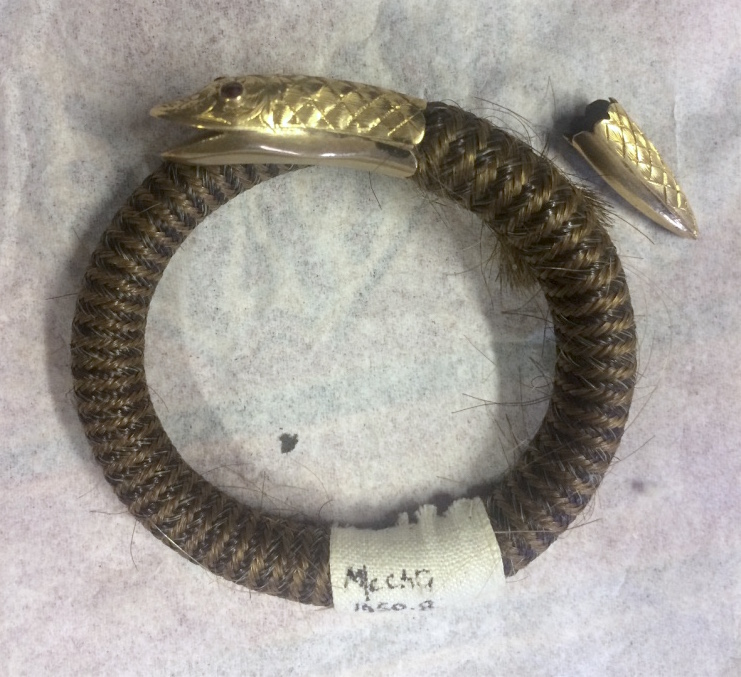By Heather Hind

Hairwork—the art of crafting decorative objects, such as jewellery, from human hair—produces a uniquely tactile token of the body. It is hair made to bear the marks of exchange and possession. While locks of hair may be cut, exchanged, and kept as mementos of family, friends, or romantic partners, hairwork codifies the dynamics of these relationships in a way that unworked hair does not. The way hair is carefully plaited or coiled and tied becomes a metaphoric anchor for complex and sometimes contrary meanings and ideas, identities and alliances. Hairwork makes manifest touch, labour, creativity, and the desire to beautify and preserve in anticipation of distance or death. Yet, as a material memento, it also evidences the signs of wear, friction, pressure, and damage that follow its use and display.
In the course of my research on Victorian hairwork, I have come across many elaborate and impressive examples of the craft in museums: necklaces, bracelet, cufflinks, earrings, brooches, hat pins, lockets, decorative flowers, and embroideries. But the objects have caught my attention are not the most skillfully worked, pristine artefacts sometimes still in their original boxes from the hairworker. Rather, it is the simple, sometimes home-made and worn and broken pieces that, lacking a box, label, letter or engraving, raise more questions than they answer. First, how is one to deduce the identity of the donor, their relationship to the recipient, and the context in which the hairwork was made? And second, how did this hairwork come to be splintered or broken, and what implications does this carry for its metaphoric signification?
For some hairwork, framed in the context of a family’s personal effects, such as the many articles of hair jewellery in the Brontë Parsonage Museum, these initial questions may be partially or hypothetically answered. This pale blonde plait was likely Anne’s, cut by her father to remember her childhood. Perhaps this dark hair belonged to Emily and was worked and worn by Charlotte following her death. Yet the issue of the use and damage of this hairwork remains at once a warm and cold sign. Multi-strand bracelets with broken plaits stand apart as particularly well-worn and well-loved, yet reveal the susceptibility of this form of memento to breakage. Loose hairs that splay out from chains and clasps show at once the apparent vitality of the matter, the crimp of the hand that worked them, and the eroding effects of use and time. By tracing the desires and anxieties that such marks of use or misuse might encode, I argue that worn and broken hairwork at once denies and endorses the threats of distance, death, and decay it was intended to ease.
To read more, see Heather Hind, “‘I Twisted the Two, and Enclosed Them Together'”: Hairwork, Touch, and Emily Brontë’s Wuthering Heights.” Victorian Review, vol. 46 no. 1, 2020, p. 31-47. Project MUSE, doi:10.1353/vcr.2020.0014.
